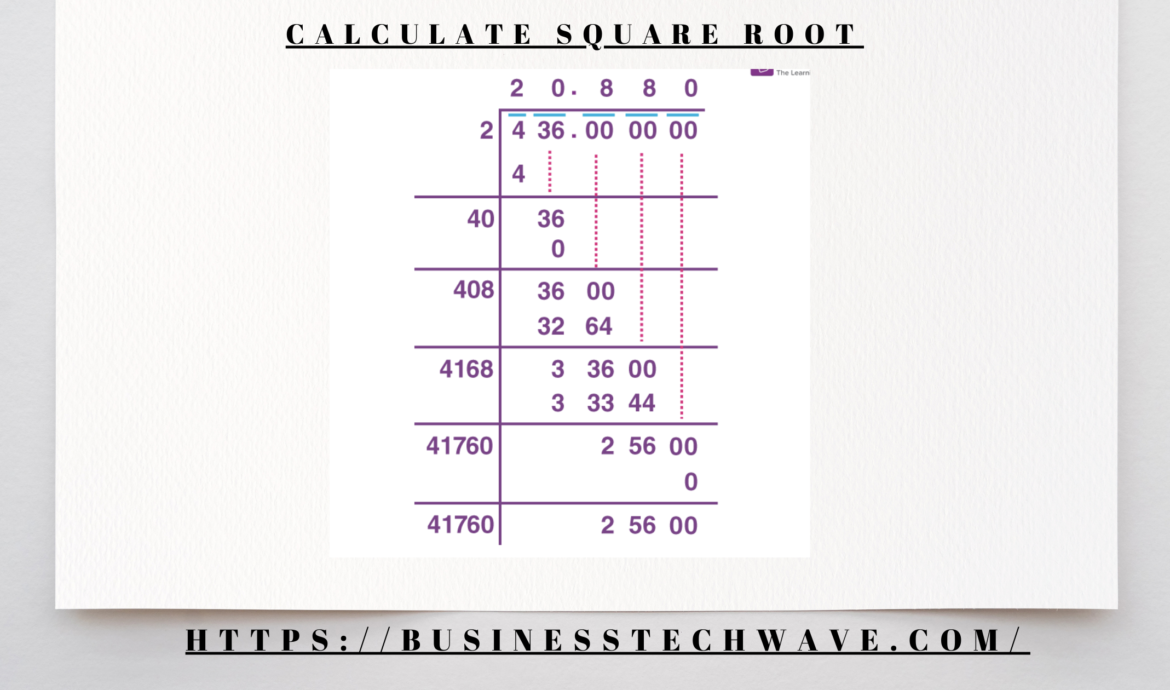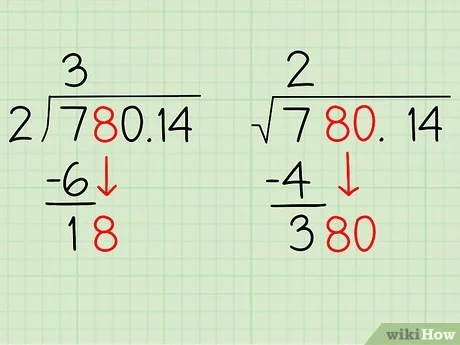
How to Calculate Square Root: A Comprehensive Guide 2024
Ramzanmughal103@gmail.com October 21, 2024 ArticleSquare roots are an essential mathematical operation used in various fields, including engineering, science, and everyday problem-solving. Whether you’re dealing with complex equations or need to perform a simple calculation, understanding how to calculate square roots efficiently is crucial. In this article, we’ll dive into different methods to calculate square roots and break down the concept for both beginners and advanced learners. Moreover, we’ll use the keyword “calculate square root” 15 times throughout the content to help enhance your SEO experience. Let’s get started!
What is a Square Root?

A square root of a number is essentially a value that, when multiplied by itself, gives the original number. For instance, the square root of 16 is 4 because 4 × 4 = 16. The symbol used to denote a square root is √, so √16 = 4. Calculating square roots is fundamental in various mathematical applications, and there are multiple ways to approach it.
Why Learn to Calculate Square Root?
Understanding how to calculate square root is not just important in school math problems; it has numerous practical applications. You may need to calculate square roots when dealing with areas, volumes, or other measurements in geometry. Engineers use square roots to determine magnitudes in design calculations, and scientists frequently rely on square roots in statistical analysis. Hence, knowing how to calculate square root can come in handy in a variety of disciplines.
Methods to Calculate Square Root
There are several ways to calculate square root, depending on the precision you need and the tools available. Here, we will explore manual methods, calculator techniques, and programming solutions to calculate square root.
1. Prime Factorization Method
The prime factorization method is one of the oldest manual methods to calculate square root. It is best used when dealing with perfect squares (numbers like 4, 9, 16, 25, etc.). Here’s how to do it:
- Step 1: Break down the number into its prime factors. For example, to calculate the square root of 36, break it down as:
- 36 = 2 × 2 × 3 × 3
- Step 2: Group the prime factors in pairs.
- 36 = (2 × 2) × (3 × 3)
- Step 3: For every pair, take one number.
- √36 = 2 × 3 = 6
Thus, the square root of 36 is 6. The prime factorization method is efficient for small numbers and perfect squares, but it becomes cumbersome for larger or non-perfect square numbers.
2. Long Division Method
The long division method is a more accurate manual technique, especially for non-perfect squares. Here’s how to use it to calculate square root:
- Step 1: Start by grouping digits of the number in pairs from right to left.
- Step 2: Find the largest number whose square is less than or equal to the first group of digits and use it as the first digit of your square root.
- Step 3: Subtract its square from the first group and bring down the next pair of digits.
- Step 4: Double the current square root, append a digit, and multiply by that digit to continue the long division process until you’ve calculated the desired precision.
Although tedious, the long division method is reliable and effective for calculating square roots by hand.
3. Calculator Method
Perhaps the easiest and most common way to calculate square root today is using a calculator. Most scientific calculators have a dedicated square root button (√). Here’s how to use it:
- Step 1: Enter the number you wish to calculate the square root for.
- Step 2: Press the square root (√) button.
- Step 3: The result will be displayed instantly.
For instance, to calculate the square root of 81, type “81” and then press “√.” The calculator will show the answer as 9.
4. Newton’s Method (Iterative Approach)
Newton’s method, also known as the Newton-Raphson method, is an iterative process that allows for approximating square roots. It’s particularly useful for numbers that do not have a perfect square. Here’s the step-by-step process to calculate square root using this method:
- Step 1: Start with an initial guess, say x0x_0x0.
- Step 2: Use the formula: xn+1=12(xn+Sxn)x_{n+1} = \frac{1}{2}\left(x_n + \frac{S}{x_n}\right)xn+1=21(xn+xnS) where SSS is the number for which you want to calculate the square root.
- Step 3: Repeat the formula until xnx_nxn converges to a stable value.
For example, to calculate the square root of 25 using Newton’s method, start with x0=5x_0 = 5×0=5. Applying the iterative formula gives more precise results with each iteration.
5. Using Python to Calculate Square Root
Programming is another effective way to calculate square roots, especially when working with large numbers or repetitive calculations. Python, a popular programming language, provides a straightforward way to calculate square roots with the built-in math library.
Here’s how to calculate square root in Python:
pythonCopy codeimport math
result = math.sqrt(25)
print(result)
In this example, the output will be 5.0 because the square root of 25 is 5. Python’s math.sqrt() function provides a fast and efficient way to handle square root calculations in any project.
Common Mistakes When Trying to Calculate Square Root
While calculating square roots may seem simple, there are common mistakes you should avoid:
- Incorrect grouping of digits in the long division method: Ensure that you group the digits correctly for the method to work efficiently.
- Assuming non-perfect squares are integers: Most square roots of non-perfect squares are irrational numbers, meaning they go on infinitely. Be aware of this and use an appropriate approximation method when necessary.
- Rounding too early: If you’re working with a non-perfect square and need a high degree of precision, avoid rounding off numbers too early in your calculation process.
Real-World Applications of Square Roots
Understanding how to calculate square root can have practical implications in various real-life situations:
- Geometry: To find the diagonal of a square or rectangle, you’ll often need to calculate square root using the Pythagorean theorem.
- Physics: Many physics formulas, such as those involving energy and force, require you to calculate square root to determine magnitudes.
- Finance: In finance, square roots play a crucial role in calculating volatility and risk measures like the standard deviation.
Tips for Learning How to Calculate Square Root Faster
- Practice mental math: Try calculating square roots of small perfect squares in your head.
- Use technology: Familiarize yourself with scientific calculators and programming languages like Python that can easily calculate square root.
- Understand the method: Whether it’s the prime factorization or long division method, understanding the logic behind these techniques can make square root calculation easier.
Conclusion
Learning how to calculate square root is a vital skill in mathematics, with applications that span from everyday problem-solving to complex scientific analysis. Whether you’re using a calculator, applying manual methods like prime factorization or long division, or employing advanced techniques such as Newton’s method, knowing how to calculate square root will serve you well in various fields.
By mastering these techniques, you’ll find yourself more confident in handling square roots in any scenario. So, the next time you encounter a problem requiring you to calculate square root, you’ll have the tools and understanding necessary to find the solution quickly and accurately.
Leave a Reply